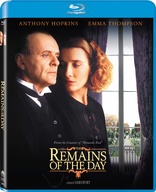The Remains of the Day Blu-ray Movie
HomeThe Remains of the Day Blu-ray Movie 
Sony Pictures | 1993 | 134 min | Rated PG | Dec 17, 2019Movie rating
7.9 | / 10 |
Blu-ray rating
| Users | 0.0 | |
| Reviewer | 4.0 | |
| Overall | 4.0 |
Overview
The Remains of the Day (1993)
In post-World War I England, head butler Stevens has devoted his life entirely to service. With careful and unfailing devotion, he adheres to a system of old-fashioned propriety. His worldview is challenged and complicated by a vivacious housekeeper who falls in love with him and for whom he cares deeply, though he is unable to directly express it. Stevens must also quietly contend with the fact his master, Lord Darlington, is an influential, yet naïve gentleman under the spell of Nazi sympathizers.
Starring: Anthony Hopkins, Emma Thompson, James Fox, Christopher Reeve, Peter VaughanDirector: James Ivory
| Drama | Uncertain |
| Romance | Uncertain |
| Period | Uncertain |
Specifications
Video
Video codec: MPEG-4 AVC
Video resolution: 1080p
Aspect ratio: 2.39:1
Original aspect ratio: 2.39:1
Audio
English: DTS-HD Master Audio 5.1 (48kHz, 24-bit)
English: DTS-HD Master Audio 2.0 (48kHz, 16-bit)
French: Dolby Digital 2.0 (224 kbps)
Spanish: Dolby Digital 2.0
5.1: 1790 kbps; 2.0 Stereo: 1698 kbps
Subtitles
English SDH, French, Spanish
Discs
Blu-ray Disc
Single disc (1 BD)
Playback
Region A, B (C untested)
Review
Rating summary
| Movie | 4.0 | |
| Video | 4.0 | |
| Audio | 3.5 | |
| Extras | 2.5 | |
| Overall | 4.0 |
The Remains of the Day Blu-ray Movie Review
Reviewed by Dr. Stephen Larson February 1, 2020In his book Fires were Started: British Cinema and Thatcherism, Andrew Higson observes that with the passage of the National Heritage Acts of 1980 and 1983, the British people gained greater access to the commodification, exhibition, and display of the heritage industry, which promotes contemporary tourism and service industries. Motion pictures are inextricably part of this industrial platform. Indeed, from the early Eighties onward, British heritage films—many of them literary adaptations made by the triumvirate of screenwriter Ruth Prawer Jhabvala, producer Ismail Merchant, and director James Ivory—arrived in the international marketplace when Prime Minister Margaret Thatcher’s England and other countries underwent a capitalist recession. Higson defines "heritage" as connoting a stabilization with the past and a preservation of traditions and values. Higson characterizes heritage cinema as a quality costume drama set in the imperial past of upper-class England. Heritage films have played a viable role in the modern British art cinema (which straddles the line between classical European art films and mainstream cinema in Britain) as they cater to an older cultural elite well-versed in English literary works, music, painting, and other venerable arts.
Merchant Ivory’s The Remains of the Day (1993) stands out from other screen adaptations in the heritage/nostalgia film canon because it attempts to establish a direct political discourse about pre-World War II Europe in its narrative. Adapted from Kazuo Ishiguro’s 1989 Man Booker-Award winning novel, The Remains of the Day (hereafter cited as Remains) explores how class distinctions between the aristocracy/haute bourgeoisie and working classes create sexual repression amongst the characters (i.e., they are seduced by class), which contributes to a blind ignorance to global affairs hovering gravely over Britain on the eve of WWII. The film shows how pre-WWII upper class society in England had abandoned morals for rules as the hallmark of civilized society and that the working class in both cultures, seduced by the opulent lifestyles of their betters, had fallen prey to the same blind adherence to rules rather than action based on passions and moral convictions.
However, although Remains is the most politically charged work in Merchant Ivory’s career, the film’s critique of fascism and anti-Semitism is ultimately undermined by their predilection stylistically for "circumambience," which author Martin A. Hipsky defines as "a spectacular excess of signification that is unironically meant to provide great sensual pleasure." In Remains, Merchant Ivory decorate the mise-en-scène with an overabundance of architectural grandeur (i.e., "eye candy") and splendid views of the English countryside which not only supply audiences with images of nostalgia and vicarious pleasure, but also prevent them from "seeing" the death of the British aristocracy.
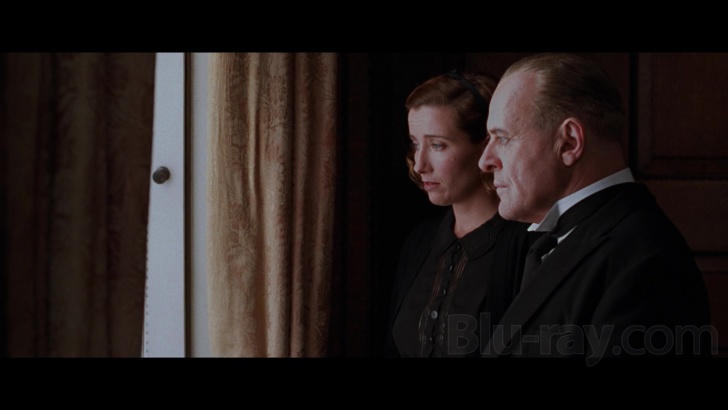
One reason that Remains is nostalgic on screen is because it looks back at events rather sentimentally in hindsight. The film integrates a dual perspective through flashbacks and alternating narration by its two main characters. Specifically, the film digresses from the novel in that it mostly prunes Ishiguro’s first-person narration. Instead of the novel’s diary narrative delivered by Stevens, the film oscillates between letter-readings by Miss Kenton (Emma Thompson), the housekeeper of Darlington Hall, and Mr. Stevens (Anthony Hopkins), who’s the "perfect" butler for Lord Darlington (James Fox). Jhabvala and Merchant Ivory objectify this mode of narration through voice-overs, flashbacks, and a non-subjective camera, which result in an erasure of Ishiguro’s social criticism. The film only gives a cursory glance at the war’s origins (mid- to late-1930s) and the disintegration of Britain’s oligarchy thirteen years after the end of the war (1958). It also falters narratively for a prime concentration on the failed love story between Stevens and Miss Kenton. Remains thus sacrifices its commentary on Britain’s declining status as Empire (so central to Ishiguro’s novel) in favor of the relationship between Stevens and Miss Kenton, which is relegated to a romantic subplot in the book. The ill-fated romance becomes the central plot in Merchant Ivory’s filmed version. As an adaptation, Remains only superficially broaches several sociocultural and political themes that pervade Ishiguro’s text through Merchant Ivory’s threaded narrative.
Remains is a quintessential heritage film not only because it summons its audience to the surface pleasures of the immediate post-Edwardian era, but also because it invites its audience to trust the honorable butler, Stevens. The caveat is that while we may view Stevens as an unreliable narrator in the novel, we become invested in the version Jhabvala creates for him on screen and forget that the character is politically problematic because he projects steadfast obedience to his fascist lord and Nazi sympathizers who visit the country house. (Hence this is a criticism of the screenwriter’s interpretation of Stevens and not Hopkins’s performance, which is first-rate.)
The Remains of the Day Blu-ray Movie, Video Quality 
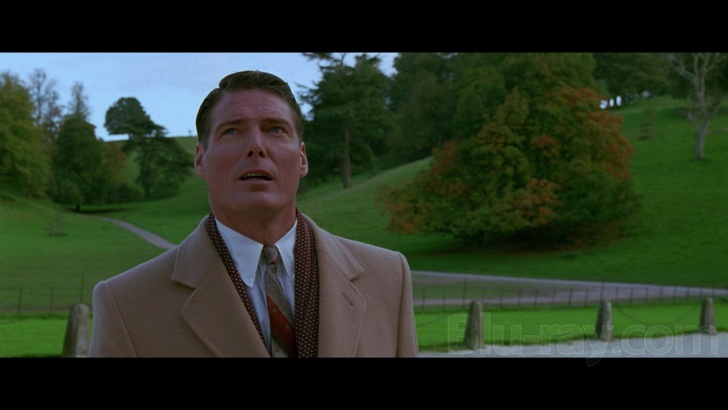
Sony has released The Remains of the Day in the US using the MPEG-4 AVC encode on a regular BD-50. This is the third edition of the eight-time Oscar-nominated film we've covered. Svet reviewed Sony UK's 20th Anniversary Edition while Jeff critiqued Twilight Time's 2015 disc. All BDs date from a 4K restoration completed ca. 2012 that was projected in select cinemas in the UK and US. I've seen Remains many times and the Blu-rays have cleaned up age-related artifacts that somewhat plagued Columbia TriStar's 2001 Special Edition DVD. But the BD transfers are not identical. The Sony's faux-like grain, which is a little more apparent than TT's slightly clearer and sharper image, distracted me at times because it didn't look as organic as it maybe should. It appeared more like mosquito noise to my eyes. It has a very coarse appearance at the large conference dinner (see Screenshot #3). Overall, the TT has a bit less noise. Sony does expunge a damage mark present on the TT. (In the sky above the middle of the castle before the great hunt.) See the comparison in shots 24 and 25. TT has substantially better compression than Sony. Exteriors look lush with clean and bright green grass on both transfers.
While shot in Technicolor, Remains predominately uses solid blacks and pure whites in many of Darlington Hall's interior scenes. Director of photography Tony Pierce-Roberts told Brooke Corner of American Cinematographer magazine that poor weather permitted him to generate dull gray light; sparse sunshine was only added for interiors. Notice the medium close-up in Screenshot #5 of Kenton and Stevens, who are nearly in full silhouette except for some sparse fill light in the background. (Most days of shooting ended by 4:30 in the afternoon so the filmmakers used a "less is more" approach to make the most of a relatively dark film that befits its gloomy subject matter.) Ivory sought a "grubby" look for Darlington Hall; although he wanted it to appear attractive from a distance, he also thought it should look dour up close. Remains's aesthetics also depart from the rustic exteriors and ripe beauty of the midday sun seen in two previous films Pierce-Roberts shot for Merchant Ivory: A Room with a View (1986) and Howards End (1992), both of which dictated rich light.
Screenshot #s 1-15, 17, 19, 21, 23, & 25 = Sony 4K Scan 2019 BD-50
Screenshot #s 16, 18, 20, 22, & 24 = Twilight Time 4K Scan 2015 BD-50
The Sony disc does have a main menu, which includes sixteen scene selections.
The Remains of the Day Blu-ray Movie, Audio Quality 
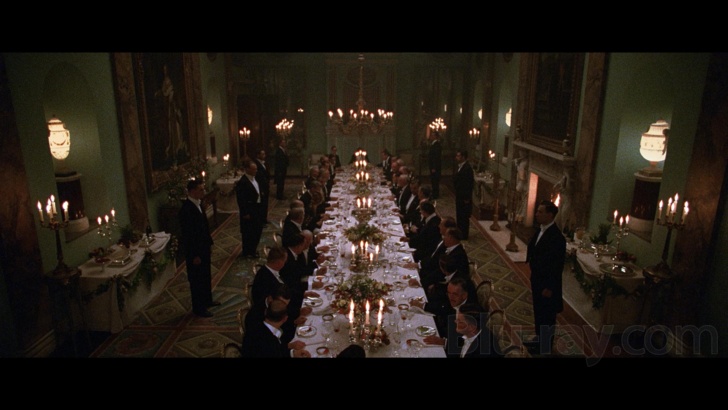
Sony supplies both an English DTS-HD Master Audio 5.1 Surround remix (1790 kbps, 16-bit) and an English DTS-HD Master Audio 2.0 Stereo (1698 kbps, 16-bit). Sony's lossless 5.1 doesn't nearly have the same amplitude and range as TT's uncompressed mix (DTS-HD MA 5.1; 3570 kbps, 24-bit). Dialogue by the mostly British cast is completely audible and often captured while the characters are near the camera. Voice-overs delivered by Emma Thompson and Anthony Hopkins are heard very clearly on the center channel. Richard Robbins's score has an air of longing about it. Extended pieces scored with rich and haunting strings are backed by occasional synths that don't sound dated. Besides door-closings and footsteps, music takes up much of the surround channels' activity.
Optional English SDH as well as French and Spanish subtitles are available for the feature only.
The Remains of the Day Blu-ray Movie, Special Features and Extras 
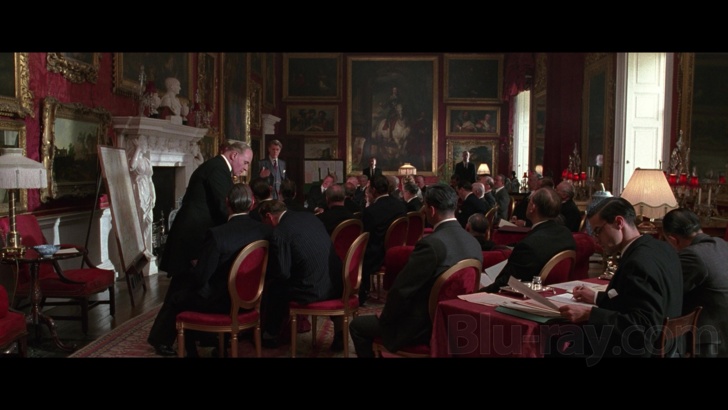
All supplements (except for one deleted scene about Mr. Stevens Sr. and an international trailer) originally appeared on the 2001 SD of Remains. Please refer to Svet and Jeff's reviews for details on the extras. These are all on the TT but the European BDs lack the feature-length commentary.
- Audio Commentary with Director James Ivory, Producer Ismail Merchant, and Actress Emma Thompson
- Love and Loyalty: The Making of The Remains of the Day Featurette (28:37, 480i)
- The Remains of the Day: The Filmmakers Journey Featurette (29:52, 480i)
- Blind Loyalty, Hollow Honor: England's Fatal Flaw Featurette (14:51, 480i)
- 7 Deleted Scenes with Optional Director's Commentary (14:27, 480i)
- Theatrical Trailer (2:23, 1080p)
- International Theatrical Trailer (2:24, 1080p)
The Remains of the Day Blu-ray Movie, Overall Score and Recommendation 
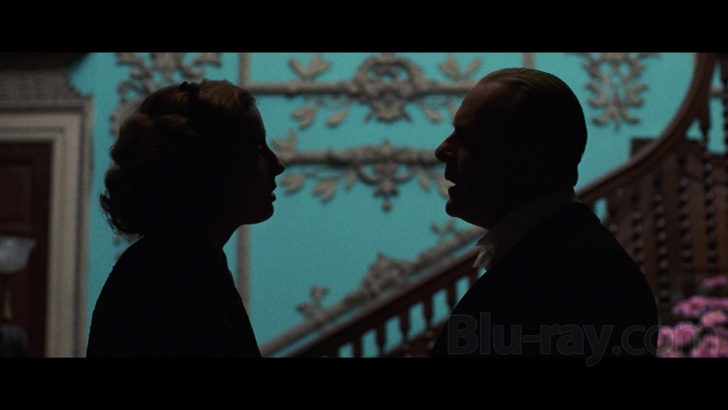
I know that I'm hard on the screen version of The Remains of the Day for depoliticizing Ishiguro's novel and celebrating the throes of hierarchy and tradition in post-Edwardian England. But as a standalone period drama, it's an enjoyable tour gaze of the lavish country houses and privileged lives of politically dimwitted European dignitaries as well as their less fortunate servants. I've seen nearly all the films Merchant Ivory worked on and would rank this one below Maurice (1987) and Howards End (1992). I believe The Golden Bowl (2000) is highly underrated with a spiffy Blu-ray release being long overdue. I'd also very much like to see respectable high-def editions done of Mr. & Mrs. Bridge (1990), Surviving Picasso (1996), and A Soldier's Daughter Never Cries (1998). This BD-50 from Sony has its pros and cons. I appreciate the studio including the original stereo surround track but sonic qualities in the 5.1 remix rank below Twilight Time's 24-bit track. I'm glad to also have the Sony release but grab any remaining copies of TT while they last (it also includes an exclusive isolated score and leaflet).
Other editions
The Remains of the Day: Other Editions

The Remains of the Day
Limited Edition to 3000 - SOLD OUT
1993

The Remains of the Day 4K
30th Anniversary Edition
1993
Similar titles
Similar titles you might also like
(Still not reliable for this title)

Orlando
1992

The Deep Blue Sea
2011

The Way We Were 4K
50th Anniversary
1973

The Life and Death of Colonel Blimp
1943

Desert Hearts
1985

Wild River
Fox Studio Classics
1960

Havana
1990

Weekend
2011

The Reader
2008

Howards End 4K
1992

Allied 4K
2016

The Unbearable Lightness of Being
1988

The Age of Innocence
1993

The Piano 4K
1993

The Master
2012

Reds
40th Anniversary Edition
1981

Her
2013

Shampoo
1975

Days of Heaven 4K
1978

All the King's Men
2006
